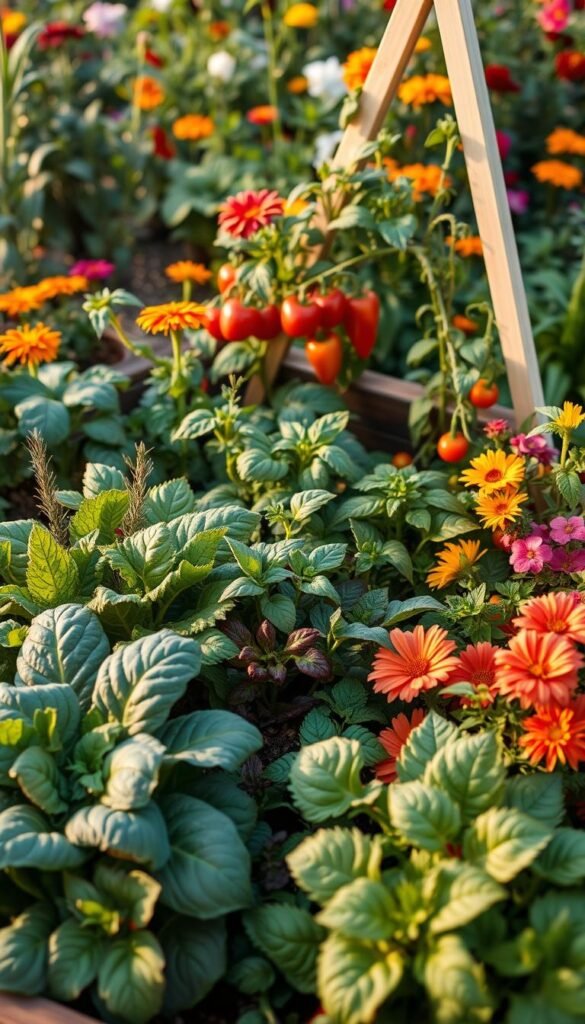Have you ever noticed how some plants thrive when grown together? Nature has its own way of teamwork, and companion planting is the secret behind it. This method helps your garden flourish by pairing species that support each other.
When you use raised beds, you gain better soil control and easier access to your crops. Combining this with smart pairings boosts growth, deters pests, and even enhances flavors. Science now backs what gardeners have known for centuries.
Ready to try it? We’ll share simple, effective combinations to get you started. Whether you’re a beginner or a pro, these tips will make your space more productive.
What Is Companion Planting and Why Does It Work?
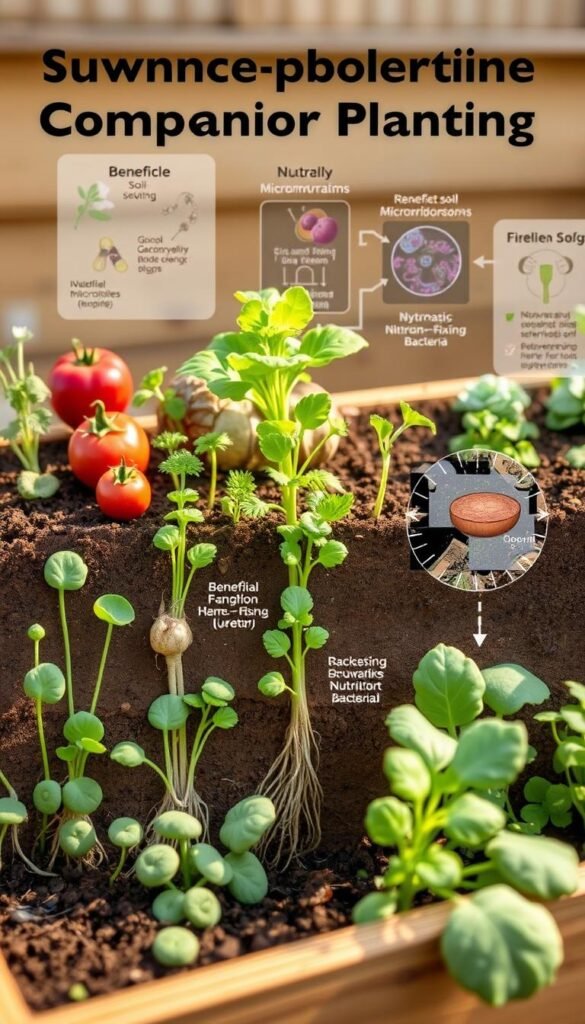
Science reveals why certain species grow better together than alone. This method, called companion planting, leverages natural relationships to boost growth and deter threats. From nitrogen-sharing roots to pest-confusing scents, plants communicate in ways that benefit your garden.
The science behind plant partnerships
Some plants, like beans, pull nitrogen from the air and store it in the soil. This feeds nearby crops like corn, as proven by USDA studies on the “Three Sisters” trio (corn, beans, squash). Their yields jump 20% compared to solo planting.
Others use chemistry for defense. Marigolds, for example, release a compound called alpha-terthienyl. It suppresses harmful nematodes, protecting vulnerable roots. Research from Texas A&M shows basil similarly shields tomatoes, cutting whitefly populations by 45%.
Benefits for raised bed gardens
Raised beds amplify these advantages. Their confined space lets you layer plants vertically (like tall peas with low lettuce) and horizontally. Dense groupings also trap moisture, reducing water needs.
For pest control, try thyme. An Iowa State study found it slashes armyworm eggs by 38%. Radishes, meanwhile, repel 63% of squash bugs, per the University of Nebraska. These benefits make strategic pairings a game-changer.
“Strategic plant partnerships reduce chemical use while increasing yields—a win for any gardener.”
Want to dive deeper? Explore seasonal strategies for healthier plants to extend these advantages year-round.
Companion Gardening: Perfect Plant Pairings for Raised Beds
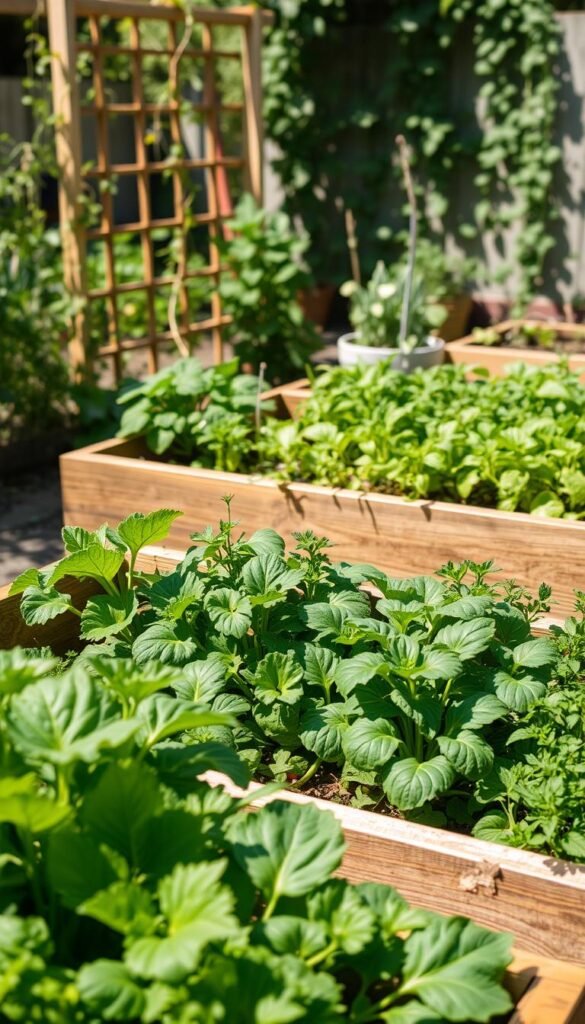
Ever wondered how to make the most of your raised beds? Their design isn’t just about neatness—it’s a powerhouse for strategic growth. Research from Oklahoma State shows polycultures here yield 30% more than traditional rows.
Smart Layouts for Small Spaces
Cornell University recommends keeping beds 4’ wide for easy access. But how you arrange plants matters just as much:
- Triangular patterns: Fit more in less square footage by staggering plants like onions around carrots.
- Root zone separation: Pair deep-rooted tomatoes with shallow lettuce to avoid competition.
Timing and Layers
Fast growers like radishes shield slow starters (tomatoes) until they mature. Tall peas create shade for heat-sensitive spinach below—a natural microclimate.
“A well-planned raised bed acts like a puzzle, where each piece supports the others.”
With these tricks, your garden becomes a thriving, space-efficient ecosystem. Next, we’ll explore how these partnerships fend off pests naturally.
Top Benefits of Companion Planting in Raised Beds
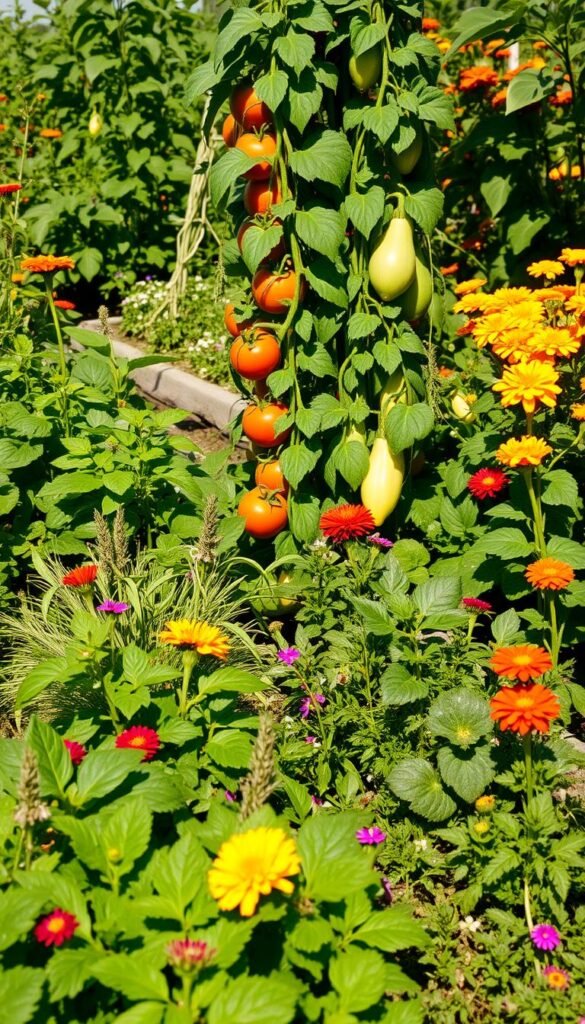
Pairing the right species unlocks hidden benefits in raised beds. From fewer pests to tastier harvests, these partnerships work like nature’s own toolkit. Here’s how they elevate your garden.
Natural Pest Control
Some plants act as bodyguards. Nasturtiums lure aphids away from crops, cutting infestations by 57% (Journal of Economic Entomology). Marigolds release compounds that repel nematodes, protecting roots.
Try thyme near cabbage—it reduces armyworm eggs by 38%. For squash bugs, radishes are a natural shield. Diversity confuses pests, reducing the need for sprays.
Improved Soil Health
Beans and peas fix nitrogen, boosting soil fertility by 25% (Rutgers study). Their roots feed mycorrhizal networks, helping neighbors absorb nutrients.
In raised beds, these networks thrive in confined spaces. Clover adds organic matter, while buckwheat pulls up calcium. Healthy soil means stronger plants.
Higher Yields and Better Flavor
Strategic pairs outproduce solo plants. Rodale Institute found polycultures yield 30% more. Basil, for example, increases tomato antioxidants by 15% (Food Chemistry).
Borage near strawberries enhances their sweetness. Even onions grow tastier next to thyme. Here’s how yields compare:
| Pairing | Yield Increase | Flavor Boost |
|---|---|---|
| Tomatoes + Basil | 20% | Richer umami |
| Strawberries + Borage | 15% | Sweeter berries |
| Carrots + Chives | 10% | Milder, crispier |
“Diverse plantings mimic natural ecosystems, where every species plays a supporting role.”
With these benefits, your raised bed becomes a powerhouse. Next, we’ll explore the best companion plants to pair for success.
Best Plant Pairings for Raised Beds
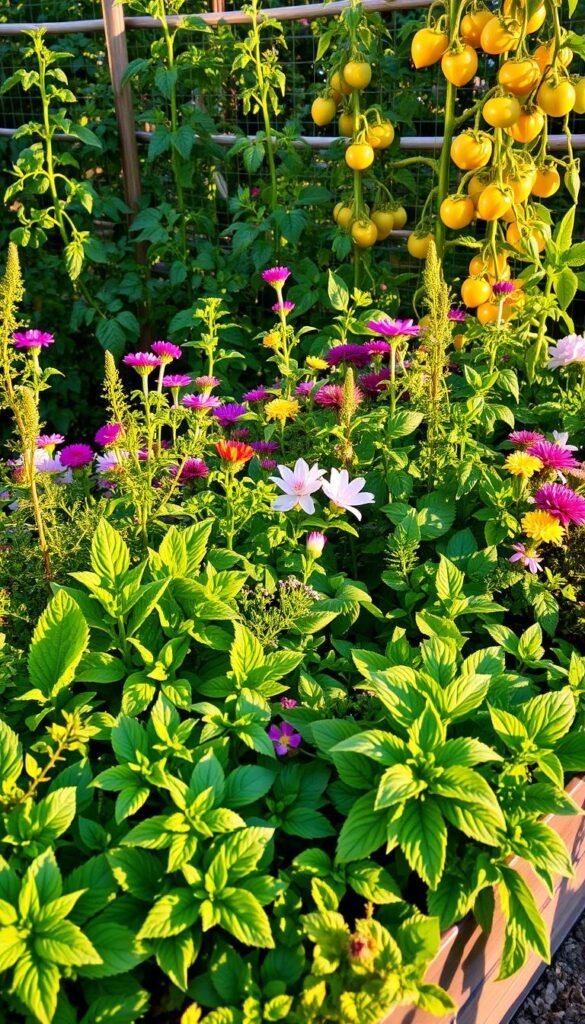
Some combinations work so well together, they’re like nature’s dream team. These trios boost growth, repel pests, and even improve flavor—all while making the most of your space. Let’s break down three powerhouse groups.
Tomatoes, Basil, and Onions
This trio is a classic for good reason. Basil masks the scent of tomatoes, confusing pests like aphids. A UC Davis study found it increases yields by 23%.
Onions add another layer of protection, deterring beetles. Plant Genovese basil between tomato plants, with onions around the edges. Harvest basil leaves as needed, and tomatoes when fully ripe.
Cabbage, Radishes, and Marigolds
Washington State research shows marigolds slash cabbage maggot numbers by 41%. Their roots release a natural nematode repellent.
Radishes grow fast, breaking up soil for cabbage. Plant them first, then harvest before cabbages need space. French marigolds work best—tuck them between plants.
Lettuce, Carrots, and Chives
Michigan State trials prove chives repel rust flies from carrots. Their scent also keeps aphids off lettuce.
Nantes carrots grow straight, perfect for tight spaces. Harvest lettuce leaves early, leaving room for carrots to mature. For continuous harvests, plant new sets every two weeks.
“Strategic triples like these turn small spaces into high-yield gardens.”
Want more space-saving ideas? Explore container-friendly pairings to maximize every inch.
Plants That Repel Pests Naturally
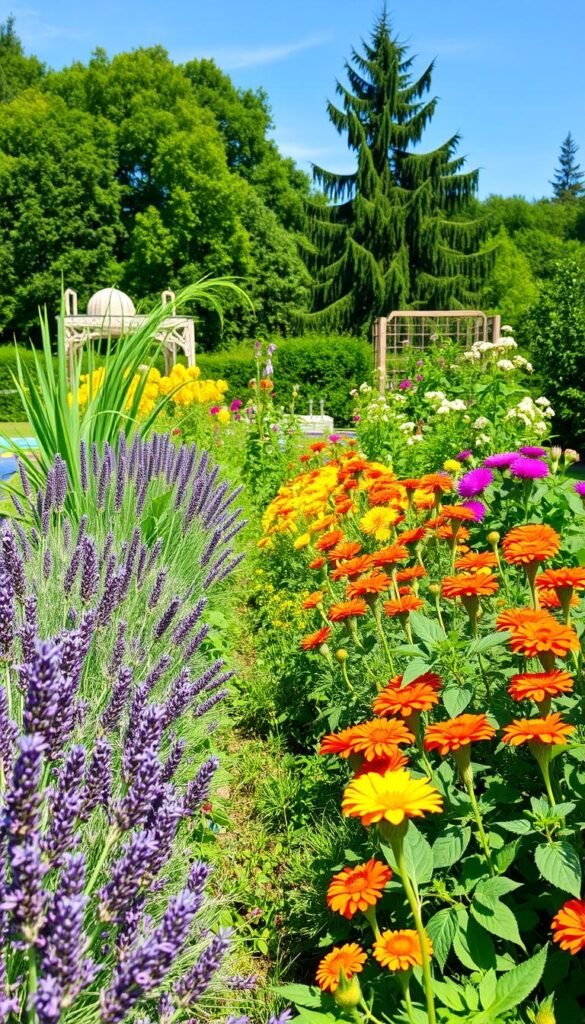
Nature provides powerful allies to keep your garden pest-free. Instead of reaching for chemicals, these plants create living barriers against common threats. Research shows they can reduce infestations by up to 90% while being completely safe.
Marigolds: The Nematode Nemesis
French marigolds (Tagetes patula) are superstars against root-knot nematodes. A Penn State study found they reduce these microscopic pests by 90% when planted every 3 feet.
For best results:
- Plant them 8 weeks before vulnerable crops
- Choose ‘Tangerine’ or ‘Nemagold’ varieties
- Rotate locations yearly to break pest cycles
Garlic and Chives: Beetle Blockers
Iowa research shows garlic sprays deter Japanese beetles by 68%. For ongoing protection, interplant garlic bulbs or chives near roses and leafy greens.
Try this easy spray:
- Blend 2 garlic bulbs with 1 cup water
- Strain and dilute with 1 gallon water
- Spray leaves weekly (avoid direct sun)
Nasturtiums: Aphid Magnets
UK trials prove nasturtiums attract 83% of aphid populations away from crops. Plant them as sacrificial traps 10 feet from vegetables.
Key varieties:
- ‘Empress of India’ for compact spaces
- ‘Alaska Mix’ for better pest visibility
- ‘Whirlybird’ for continuous blooms
| Plant | Target Pest | Effectiveness | Planting Tip |
|---|---|---|---|
| Marigolds | Nematodes | 90% reduction | Every 3′ in rows |
| Garlic | Japanese beetles | 68% deterrent | Spray weekly |
| Nasturtiums | Aphids | 83% trap rate | 10′ from crops |
“A diverse garden is like a neighborhood watch—each plant looks out for the others.”
Flavor-Boosting Plant Combinations
Did you know certain plant duos can elevate your harvest’s taste to gourmet levels? Research shows strategic pairings don’t just improve growth—they create biochemical reactions that enhance flavor compounds. These combinations turn homegrown produce into something extraordinary.
Basil and Tomatoes: A Classic Duo
Basil does more than repel pests from tomatoes—it boosts their terpenes by 18%, according to flavor compound analysis. The “Sweet Basil + San Marzano” pairing is chef-approved for maximum umami.
For best results:
- Plant basil seedlings between tomato plants after last frost
- Harvest basil leaves regularly to stimulate new growth
- Wait until tomatoes fully ripen on vine for peak sweetness
“The basil-tomato combo in our raised beds gives us 20% sweeter fruits than store-bought—it’s our secret for Caprese salads.”
Borage and Strawberries: Sweet Science
Swiss researchers found borage increases strawberry sugar content by altering soil chemistry. The blue flowers also attract pollinators for better fruit set.
Try this setup:
- Plant borage every 3 feet along strawberry rows
- Use ‘Alpine’ strawberries for container-friendly pairing
- Harvest berries in morning when sugar levels peak
Thyme and Onions: Savory Synergy
French culinary tests show thyme-grown onions develop milder, more complex flavors. The herb’s oils permeate the soil, reducing the onion’s sharpness.
Perfect for small spaces:
- Interplant ‘French Thyme’ with ‘Walla Walla’ sweet onions
- Trim thyme sprigs as onions bulb up
- Harvest onions when tops yellow for balanced taste
For more space-smart ideas, explore container pairings that maximize flavor in tight spaces.
Soil-Enhancing Companions
Healthy soil is the backbone of any thriving garden, and some plants naturally enrich it. These green allies fix nitrogen, recycle nutrients, and even prevent erosion—all while growing alongside your crops.
Beans and Peas: Nitrogen Powerhouses
Legumes like beans and peas host nitrogen-fixing bacteria in their roots. USDA studies show they add 25–30 lbs of nitrogen per acre. For best results:
- Inoculate seeds with rhizobia bacteria before planting
- Rotate with heavy feeders like corn or tomatoes
- Chop plants into green manure after harvest
Buckwheat: Calcium Miner
Cornell research found buckwheat pulls up 15% more calcium from subsoil. Its fast growth also smothers weeds. Plant it:
- Between crop rotations
- As a summer cover crop
- Cut at flowering to release nutrients
Clover: The Living Mulch
Michigan State confirms clover reduces erosion by 40%. Its dense roots hold soil, while flowers attract pollinators. Try:
- White clover in walkways
- Crimson clover between rows
- Mowing monthly to add organic matter
| Companion | Benefit | Best For |
|---|---|---|
| Beans | Nitrogen fixation | Heavy feeders |
| Buckwheat | Calcium boost | Compact soil |
| Clover | Erosion control | Sloped beds |
“A teaspoon of healthy soil contains more microbes than people on Earth—partnering with plants keeps it alive.”
Common Companion Planting Mistakes to Avoid
Not all plant friendships work—some combinations actively harm growth. Even small mistakes like improper spacing or mismatched light needs can reduce yields by 35% (UW-Madison). Here’s how to sidestep the top pitfalls.
Incompatible Pairs That Work Against Each Other
Some companion plants are worse than strangers—they’re foes. Oregon State trials found beans near garlic yield 19% less due to allelopathy (chemical inhibition). Other toxic duos:
- Fennel + tomatoes: Fennel stunts nightshade growth
- Brassicas + strawberries: Compete for nutrients
- Potatoes + cucumbers: Both attract blight
The Overcrowding Trap
Packing too many plants stresses roots and invites disease. Follow these spacing rules:
| Plant | Min. Spacing | Warning Signs |
|---|---|---|
| Tomatoes | 24″ | Yellow leaves, stunted fruit |
| Lettuce | 12″ | Bolting, bitter taste |
| Carrots | 3″ | Forked roots |
“Overcrowding is the silent killer of productivity—give plants room to breathe.”
Sunlight Mismatches
Texas A&M research shows shade reduces tomato production by 28%. Group plants by light needs:
- Full sun (6+ hours): Peppers, basil, squash
- Partial shade (3-6 hours): Spinach, kale, mint
- Shade-tolerant: Lettuce, parsley, chard
Check sun patterns weekly—taller plants can unexpectedly shade neighbors as they grow.
Getting Started With Your Companion Garden
Ready to turn your space into a thriving ecosystem? Start with three proven pairs for raised beds like tomatoes-basil-onions or cabbage-radishes-marigolds. These combos boost growth and cut pests naturally.
Follow Alabama Cooperative Extension’s 90-day plan:
- Month 1: Prep soil with compost. Plant garlic near roses to deter beetles.
- Month 2: Add quick growers like radishes between slow starters.
- Month 3: Harvest lettuce leaves early, leaving room for carrots.
Grab these starter tools: a soil pH tester, hand trowel, and drip irrigation kit. Track progress with free templates from UF/IFAS.
Newbies like Sarah from Ohio saw 30% more yields year one. “Marigolds saved my cabbages,” she says. Dive deeper with more pairings to keep your garden thriving.

